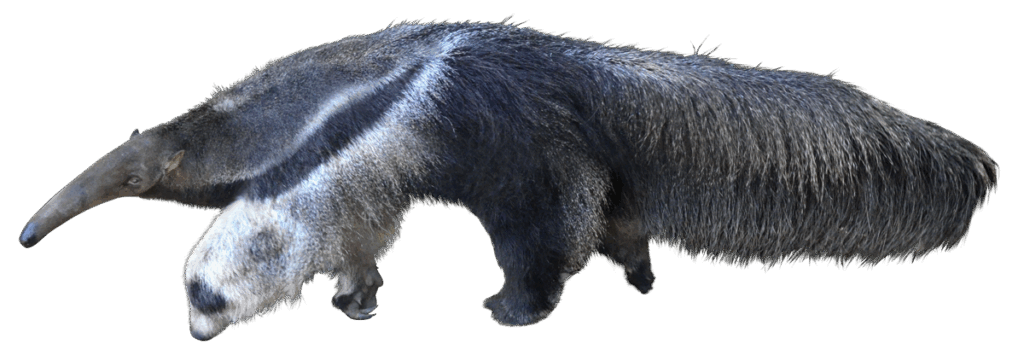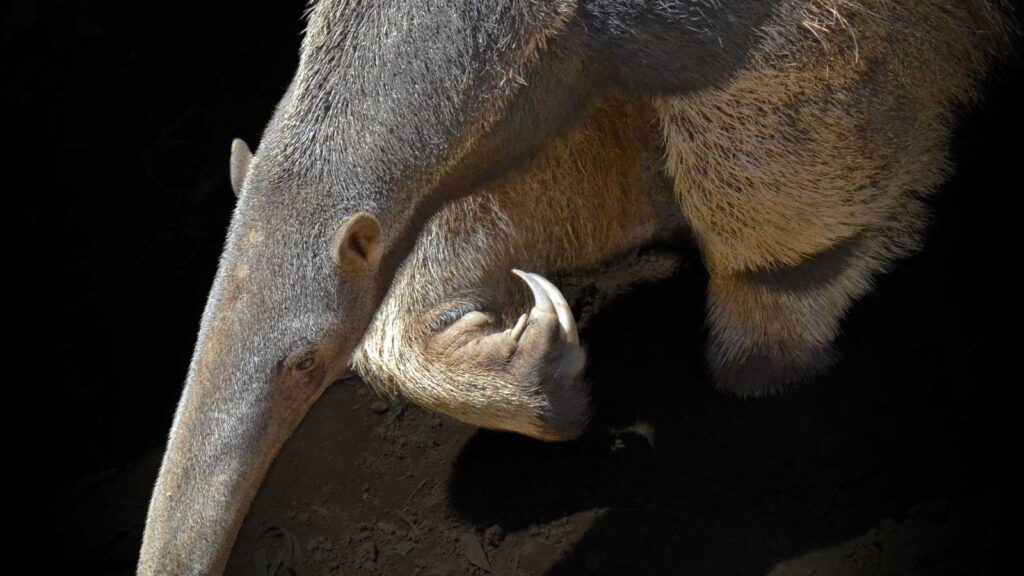
Myrmecophaga tridactyla (Linnaeus, 1758)
特異な形態には意味がある
The Unique Shape Has Meaning
全長1.8 – 2.4m、体重27 – 45kg。4種いるアリクイの仲間の中で最も大きく、中南米に分布しています。湿地・草原・熱帯林に生息しており、通常は単独で行動します。
まず独特なのは細長い顔です。長く伸びた口腔から長さ60cmにもなる舌を出し入れして、アリやシロアリを食べます。舌は粘着性のある粘膜で覆われていて、1分間に150回もの高速で出し入れすることで、一日で3万匹もの量を食べることができます。アリクイは歯を持たないので胃にそれらを粉砕するための収縮する硬化した折り目を持っています。一緒に摂取する小さな砂と土はすり潰すのに役立ちます。またアリクイは胃酸を分泌しないので、アリなどの蟻酸が消化プロセスに役立ちます。
前肢にはそれぞれ3本のカギ爪があり、真ん中(人間で言う中指)の爪は特に発達しており、アリ塚を切り裂いたり、ジャガーやピューマなどの捕食者に襲われた時に対抗する強力な武器となります。また、移動する際は手の甲側を地面につけて、ゴリラなどのようにナックルウォークの状態で歩くことで爪を保護しています。見かけによらず足は早く、必要に応じて時速48kmもの速度で移動することもできます。
尻尾は硬く長い毛で覆われていて、寒い時期の就寝時には布団代わりにして、体温調節に使われたり、カモフラージュとして捕食者を惑わせるのに役立つと考えられています。しかし尻尾の長い毛は燃えやすく、火災に対しての脆弱性があり、1994年にブラジルのエマス国立公園で発生した山火事では約340頭のオオアリクイが死亡したと報じられています。
火災の他に生息地の喪失、道路破壊、狩猟などの理由により過去10年間で生息数は30%も減少しています。 IUCNの評価ではVU(絶滅危惧II類)に分類され、絶滅の危険性が高まっています。新世界の哺乳類の中でも特にユニークで希少なオオアリクイは生物多様性保全の観点からも重要な存在です。
It is 1.8 – 2.4m long and weighs 27 – 45kg. It is the largest of the four species of anteaters and is distributed in Central and South America. It lives in wetlands, grasslands and tropical forests and usually acts alone.
The first thing that is unique is its long and thin face. It eats ants and termites by inserting its tongue, which can be up to 60cm long, into and out of its long mouth. The tongue is covered with a sticky mucous membrane and can be inserted and removed at a high speed of 150 times per minute, allowing it to eat up to 30,000 ants in a day. Since anteaters do not have teeth, they have contracting hardened folds in their stomachs to crush them. The small sand and soil they ingest also help with the grinding. Also, anteaters do not secrete stomach acid, so formic acid from ants and other foods helps with the digestion process.
Each forelimb has three claws, and the middle claw (the equivalent of the middle finger in humans) is particularly developed and serves as a powerful weapon to cut through anthills and to fight off predators such as jaguars and pumas when attacked. In addition, when moving, they protect their claws by walking with the back of their hands on the ground, like gorillas, in a knuckle-walking position. Despite their appearance, they are fast and can move at speeds of up to 48 km per hour if necessary.
Their tails are covered with long, stiff hair, which is thought to be used as a blanket to regulate body temperature when sleeping in cold seasons, and as camouflage to confuse predators. However, the long hair on their tails is flammable and vulnerable to fires. In 1994, a forest fire in Emas National Park in Brazil reportedly killed about 340 giant anteaters.
In addition to fires, habitat loss, road destruction, hunting, and other factors have led to a 30% decline in their population over the past 10 years. The IUCN has classified them as VU (Vulnerable), and they are at high risk of extinction. The giant anteater is a particularly unique and rare New World mammal, and is important from the perspective of biodiversity conservation.

Their claws and feet are powerful
参考文献
“Giant anteater” The Smithsonian’s National Zoo and Conservation Biology Institute. 2025年7月5日閲覧
野見山動物園 | 動物トピックス | アサヒの食事 | (2016年12月11日) 2025年7月5日閲覧
TierZine | その他の動物 | オオアリクイのなが〜い舌は60cm!飼育スタッフに聞いた絶滅危惧種の意外な生態 | (2024年11月11日) 2025年7月5日閲覧
McMillan, Duncan (2012, February 29) “Formic Acid” Chemistry World. 2025年7月5日閲覧
WWFジャパン | 大豆と「世界で最も生物多様性に富むサバンナ」ブラジル セラードの深い関係 | (2022年9月15日) 2025年7月5日閲覧